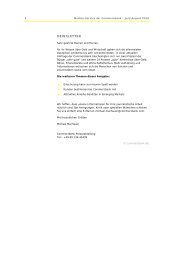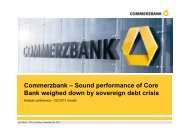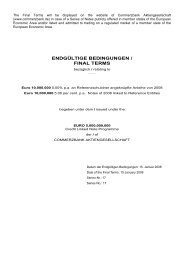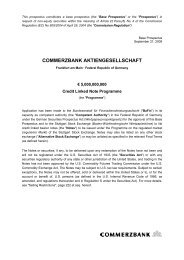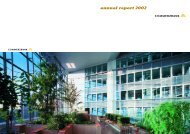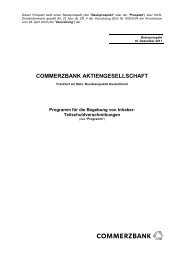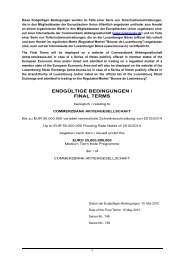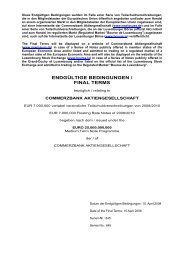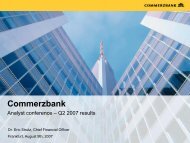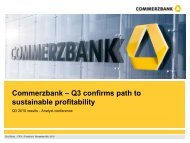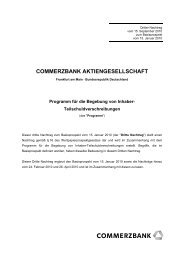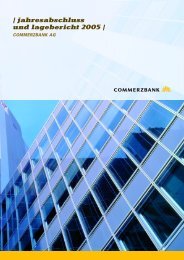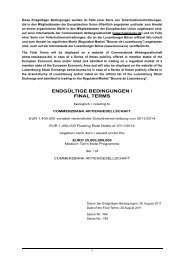COMMERZBANK AKTIENGESELLSCHAFT
COMMERZBANK AKTIENGESELLSCHAFT
COMMERZBANK AKTIENGESELLSCHAFT
You also want an ePaper? Increase the reach of your titles
YUMPU automatically turns print PDFs into web optimized ePapers that Google loves.
Group Financial Statements<br />
354<br />
298 Commerzbank Annual Report 2011<br />
(85) Market risk<br />
Market risk is the risk of financial losses due to changes in<br />
market prices (interest rates, commodities, credit spreads,<br />
exchange rates and equity prices) or in parameters that affect<br />
prices such as volatilities and correlations. The losses may<br />
impact profit or loss directly, e.g. in the case of trading book<br />
positions, or they may be reflected in the revaluation reserve or<br />
in hidden liabilities/reserves in the case of banking book<br />
positions. We also monitor market liquidity risk, which covers<br />
cases where it is not possible for the Bank to liquidate or hedge<br />
risky positions in a timely manner and to the desired extent on<br />
acceptable terms as a result of insufficient liquidity in the<br />
market.<br />
Market risk is managed by means of a sophisticated system<br />
of limits, combined with reliable and optimized methods for<br />
measuring and monitoring. Commerzbank uses economic capital<br />
(risk-taking capability) and business expectations to establish its<br />
market risk limits, which ensures a risk/reward-based<br />
management of market risk. The extent to which the limits are<br />
used, together with the relevant P&L figures, is reported daily to<br />
the Board of Managing Directors and the various heads of<br />
divisions.<br />
For the daily quantification and monitoring of market risk,<br />
especially that arising in proprietary trading, statistical methods<br />
are used to calculate the value at risk (VaR). The underlying<br />
statistical parameters for the regulatory capital adequacy<br />
requirements are based on an observation period of the past 254<br />
trading days, a 10-day holding period and a confidence level of<br />
99%. For internal market risk management the same<br />
observation period is used, with a 1-day holding period and a<br />
confidence level of 97.5%. The value at risk models are being<br />
constantly adapted to the changing environment.<br />
As a result of the takeover of Dresdner Bank and with the<br />
agreement of the German Federal Financial Supervisory<br />
Authority (BaFin) Commerzbank temporarily used two parallel<br />
market risk models which had both been approved by the<br />
supervisory authorities to determine its regulatory capital<br />
adequacy requirements in the first three quarters of 2011. For<br />
the positions of the old Commerzbank general market risk was<br />
calculated on the basis of an historical simulation, while specific<br />
interest rate risk (specific market risk) was calculated by means<br />
of a variance/covariance approach. For the positions of the<br />
former Dresdner Bank we used a VaR model based on historical<br />
data with a stochastic Gaussian normal distribution assumption.<br />
At the end of December 2011 the Federal Financial Supervisory<br />
Authority (BaFin) gave Commerzbank the authorisation to use<br />
the newly developed internal VaR model on the basis of an<br />
historical simulation to calculate both general market risk and<br />
specific interest rate risk. Commerzbank has been using this<br />
model since the fourth quarter of 2011 to calculate market risk<br />
and the capital adequacy requirements. The model includes<br />
methods and processes to calculate additional market risk<br />
indicators (Stressed VaR, Equity Event VaR and Incremental Risk<br />
Charge) to meet the Basel 2.5 regulatory requirements as of<br />
December 31, 2011.<br />
Commerzbank is now using the same market risk model<br />
based on an historical simulation for internal risk management<br />
and for calculating regulatory capital. This ensures that risk<br />
measurement is consistent across the whole Group and will meet<br />
the future requirements of Basel III.<br />
The reliability of the internal model in use at any time is<br />
regularly checked using backtesting methods. Apart from<br />
meeting supervisory requirements, the aim is to assess and<br />
steadily improve forecasting quality. The number of significant<br />
deviations is also used by the supervisory authorities as the<br />
basis for the evaluation of the internal risk models.<br />
The table below shows the group-wide regulatory market risk<br />
of the trading portfolio including the foreign exchange risks of<br />
the banking book, as used for calculating capital requirements.<br />
The value at risk shows the potential losses which will not be<br />
exceeded with a 99% degree of probability for a holding period<br />
of 10 days:<br />
Group<br />
€m 31.12.2011 31.12.2010<br />
Minimum 119.3 165.2<br />
Median 210.1 236.1<br />
Maximum 323.2 320.8<br />
Year-end figure 186.9 250.4



